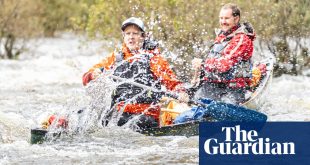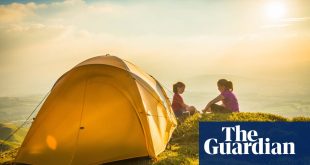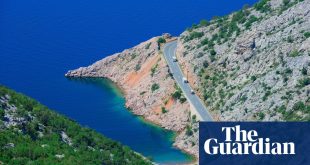The view from the ship’s bridge is what I expected: a ribbon of dark Arctic water leading through a maze of snowy mountain islands. But the view of the bridge is a shock. Where is the wheel, the chart and that big metal thing that goes “ting”? You know, the one marked “Dead Slow” and “Full Steam”, like you see in Titanic when they spot the iceberg? In its public areas, the Havila Capella looks like any modern cruise ship or upmarket ferry. There are lounges, a panoramic bar, a couple of gyms and a deck that can be strolled. It is what lies behind the bulkheads that is very different.
On a bridge that is more USS Enterprise than Titanic, Captain Brynjard Ulvøy checks the flatscreen displays. “You see, if we increase speed … ” He nods at the first officer in the comfortable chair who taps another screen. “We drain the batteries and use more liquid natural gas.” Another nod and the ship eases back a little. “At this speed, we are at our most economical.”
The chief engineer, Bjørn Jones, puts it like this: “Remember the first hybrid cars? We are at that stage with ships.”
Liquified natural gas has been criticised for its methane emissions, but on this ship other pollutants are reduced and the batteries allow four hours of low-emission sailing in environmentally sensitive areas. When Havila Capella was built, its twin 43-tonne batteries, each housed in a tennis court-size compartment, were the largest in the world.
I hurry away, back to the world of the passenger. We are on a cruise from the Norwegian port of Bergen to the most northerly fishing village in the world, a place far beyond the limit of most human settlements inside the Arctic Circle. On board we have an astronomer, ready to answer questions about the stars and aurora, should they appear. This being a winter cruise also means the weather can play a part: storms have already blown out our departure from Bergen and we had to meet the ship in Trondheim, then make a rapid departure as another squall came bashing up the fjord. Best-laid plans get rewritten, and I’m enjoying the unexpected: instead of a hike up a mountain near Ålesund, I find myself visiting the aviation museum in Bodø.
Quick Guide
LNG explainer
Show
Ocean-going ships have not been environment-friendly since the Victorian heyday of tea clippers like the Cutty Sark and Thermopylae, but the search is on. First came coal-fired then diesel, now liquid natural gas, which is largely methane cooled to -162C. “LNG ships can reduce greenhouse gas emissions by up to 23%,” says Dr Kayvan Pazouki, lecturer in marine, offshore and subsea technology at the University of Newcastle. “Not only that but they cut nitrogen emissions by up to 80% and eliminate sulphur and particulate matter.” However, there are drawbacks. “Savings in CO2 are limited,” he notes. “They cannot meet the net zero by 2050 requirement.”
Vessels such as Havila Capella augment LNG with huge batteries (equal to 600 Tesla cars). In China, the Yangtze River Three Gorges 1 is an entirely electric cruise ship, carrying up to 1,300 passengers on day trips along the river. Batteries, however, limit range and the future might see the return of wind power. The bulk carrier Pyxis Ocean is already using steel and fibreglass sails developed by British company BAR Technologies, generating fuel savings of up to 30%. Pioneering Bahamas-based Veer Group is planning to launch two wind-powered ships by 2026. “They will be the first zero-emission container ships capable of crossing oceans,” says CEO Danielle Southcott. Veer is also working on expedition cruise vessels that use the same technology.
The museum is not something I would normally choose, but I’m soon lost in the Norwegian cold war experience and also have time for a coastal walk, spotting three sea eagles before hurrying back to the departing ship. At dinner, our astronomer, Ian Ridpath, tells me he is optimistic about northern lights possibilities. “The forecast is showing some clear skies and we’re heading right under the aurora band. Kp index is not high, but there’s a coronal hole.”
I already understand what he’s talking about because I had attended his lecture in the conference room. The aurora band is a broad ring of aurora activity that circles the pole. “You can go too far north and miss the aurora,” Ian says. Tonight, and for the next couple of days, we will be directly under that prime aurora-activity sky. The Kp index – K for Kennziffer or code, p for planet – is a measure of solar activity that goes from zero to nine, nine being maximum activity. Even a low index of two can mean a decent sighting when you are under the band. A coronal hole is a cool region on the face of the sun that allows more solar wind to escape, bombarding our atmosphere in the particles that cause those magical displays.
Dinner is not one of those giant buffet blowouts found on many cruises; this is a ship that takes environmental concerns seriously, and table service significantly reduces food waste. The cuisine, however, is delicious, and delivered by the friendliest crew I’ve ever come across.
That evening, the ship is due to pass through the narrowest channel of our voyage, the Raftsundet, a 16-mile channel between two of the Lofoten islands that is barely 200 metres wide at its narrowest. Captain Ulvøy knows it well, having grown up on an island farm close to its jaws. As we pass, he points out his childhood home with a spotlight.
As we pick our way through the Lofoten archipelago, on-deck temperatures drop and the sky clears. The ship’s lights are dimmed. A plume of grey mist seems to rise in the darkness from one of many snow-clad peaks ahead, a plume that slowly coils itself, then unfurls across the sky, gaining a greenish tint with a delicate pink fringe and a reddish hem. For the next few hours the aurora display swells, fades, then reappears. The deck lights are turned back on as we approach another port: although in many respects this is a tourist trip, the ship still carries cargo to dozens of tiny ports up the Norwegian coast, bringing mail and essential supplies.
At our next big stop, Tromsø, most passengers disembark for a few hours. I go cross-country skiing around the hilly outskirts of the city, dodging folk on skies or fat bikes, many pulled by their dogs.
Despite its wintry looks, and high latitude, Tromsø benefits from the warming effects of the Gulf Stream, but after that we move around the top Arctic edge of Europe, heading east into colder air. At dawn one morning I can barely last a minute outside holding a metal camera with bare hands. The settlements have a tougher look about them and there are no snow-laden trees. Frozen vapours drift across a hard, dark sea streaked with white, and the island bays are silent with ice. We are now close to the Russian border, and in some small ports the road signs are in Norwegian and Russian, a mark of how close the ties once were: Russians popping across to do their luxury shopping; Norwegians heading east for cheap petrol.
after newsletter promotion
At Honningsvåg on the island of Magerøya we tie up and everyone disembarks. Most board coaches for a tour to North Cape, the most northerly point in Europe. Several others choose a snowshoe walk. That leaves a tiny, rather nervous-looking, group, coincidentally all British. We have chosen to swim in the Barents Sea.
A short bus ride delivers us to Skarsvåg, the most northerly fishing village in the world and the scene for our remarkable act of folly. Gøran and Sunniva run a small shop and a sauna, which they have fired up ready. There’s a fire on the jetty, too, but it doesn’t seem to be giving off any heat.
The couple are the youngest members of a dwindling population, now down to about 40. “The old ladies come and sit in the shop and knit socks,” says Gøran. “Without them I couldn’t go ice fishing.” I assume he means the socks, but maybe the indomitable nonagenarians go fishing, too. In summer this is a popular sport fishing location – visitors landing giant halibut of up to 400kg – but in winter, houses disappear under heavy snowfalls and everywhere is snow and ice. It is magical, especially viewed from the sauna after an invigorating dip.
After a few minutes in the 80C sauna, I brave the jetty and descend the steps into the sea. The air temperature is -15C. “Not too cold in the water today,” shouts Gøran. “Maybe three or four degrees.” I surprise myself by actually swimming a few metres, then my toes and fingers start begging for mercy. Once I’ve warmed up, however, an inexplicable desire to repeat the experience grabs me. It really is magical to swim surrounded by the Arctic winter in all its brutal glory.
Later, in the cafe, I eat waffles with cloudberry jam, washed down with hot coffee. I buy some locally knitted socks and discover that Gøran was right. At last, my feet warm up.
The trip was provided by Discover the World, which offers an eight-night trip from Bergen to Kirkenes, with six nights on board ship from £1,624pp with sea view cabin. Discounts are often available and non-seaview cabins are cheaper. Sauna and ice-bathing excursion from £170. Astronomy lecture series (on some voyages) £254. Holiday Extras provides insurance, transfers and car parking
 Top Naija News: Nigerian News, Breaking News Nigeria and World News Top Naija News is a daily news publication in Nigeria, delivering the latest breaking news in Nigeria and around the world.
Top Naija News: Nigerian News, Breaking News Nigeria and World News Top Naija News is a daily news publication in Nigeria, delivering the latest breaking news in Nigeria and around the world.



